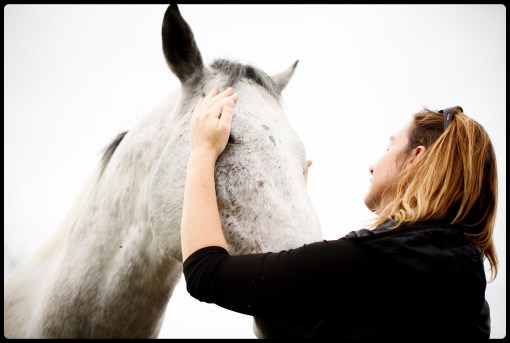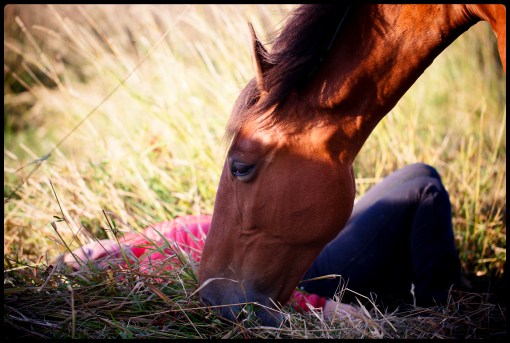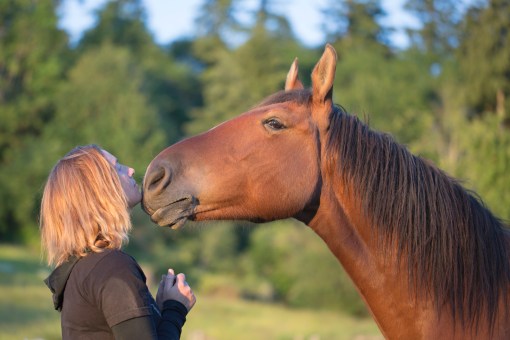The Project:
Mustangs directly off the range, One Trainer, Many Students, Communication through body language, Tools used only for safety, never to train.
The Goal:
To discover how far Equestrian Art can be developed solely using body language.
Soaking Up The Silence
December in the Pacific Northwest brings its own character-building atmosphere into play. I am finding each year I love it a little more than I did the year before. Enveloped in fog, kissed by frost, christened by the perpetual moisture in the air: rain, snow, sleet, mist or some combination of all at the same time. Cocooned in a perpetually dim cloud-covered dome of existence, only to be swept occasionally into the brilliant clarity of a piercing sunshine, visiting for a day or two before the cocoon of cloud cover wraps you again in its comforting cloak.
I feel a sense of peace, safety, and deep personal challenge here. There is something about the almost endless, deep, grey skies and the piercing clear moments of sun that break through. Almost as though the weather brings safety, challenge and clarity in waves, the same way I aim to do in relationship with my horses.
More and more I am realizing this work with horses is about being aware. Increasingly aware of why, when and how we do what we do. Nothing is meaningless; actions are tuned in as communication or are tuned out to be merely static and noise in the environment.
The world gives high praise to trainers with “good feel and good timing”. What does that mean and how does one achieve that elusive “good feel and good timing”? Can it be learned or taught? Or is it something one is simply born with or touched by, like a whimsy from a supreme deity.
I believe feel and timing are skills that can be learned, and I believe my greatest work is honing those skills each and every day.
My work begins in a foundation of silence.
I am talking about the silence of harmony. If actions and movements are sound and everything means something, silence is how we find the spaces between words and hear the music play out of the static.
Sound has meaning in counterpoint to silence.
Movement has meaning in counterpoint to other movement.
Every movement we make has a meaning, a sound, a song, a harmony or a deafening screech of meaningless static, like a radio dial that can’t find a station while we grasp desperately at the volume adjustment.
With your horse, begin with the silence. Before you play with the noise.
Soak up the silence, become one with the silence, let it tear you open and bare your soul to the world. Simply be.
As human beings I find we tend to try and fill all the silences, using words and thoughts and explanations to buffer us from feeling what actually IS in any moment.
That elusive “feel and timing” that great horse trainers have, it begins with a willingness to be quiet and soak up the silence. Only then can we feel our way through speaking with our horses in ways that bring us the relationship we seek.
This quiet I speak of, what does it mean? How does it apply with horses? It is about harmony, it is about reading the body language of the horse and knowing how to be, when to be, where to be, to speak or to be quiet.
In order to be heard or to listen well, we need to first find the silences and learn to make the silences in such a way that allows sound to have meaning and clarity when it happens.
This is feel and timing.
Imagine a chess board in the space around your horse. You are an all powerful chess piece and can move in any direction at any speed from one spot to another. Your horse has likes and dislikes, preferences and comforts that you may or may not be aware of. Spatially, does your horse like you farther away or closer to? Does your horse like you touching them or not touching them? Each horse is an individual and has a different idea of harmony.
Can you be in harmony with what this particular horse enjoys? That is finding the silence.
Can your horse be in harmony with what you enjoy? That is finding the silence.
Once you have found the silence, can you simply be there? No noise, just be there in the silence.
This is not a magical “feel the energy” type of thing, this is real and tangible and very learnable on a physical plane!
If your horse likes you five feet from their neck on the left side, can you simply be there for a while and read their body language to know you have not overstayed your welcome or worn out your harmony. When they walk, you walk; when they stop, you stop; when they breathe, you breathe; when they watch the horizon, you watch the horizon. Can you be in harmony with them? Can you soak up the silence together?
Then, can you move to another place of harmony, find another source of silence BEFORE the first one feels uncomfortable? This is timing.
Every being on earth seeks comfort. In relationship one being’s idea of comfort is often another being’s description of discomfort. Feel and timing is finding where, when and how two beings are comfortable together, and then letting the nature of relationship stretch us and develop us so we learn and evolve into finding comfort in more and different ways.
Harmony is the silence. A voluntary being together of beings is the silence I encourage you to soak in.
Move from one spatial relationship to another with a feel for harmony. Don’t wait to be kicked out of the one you are in, don’t wait for your horse to pin their ears at you, or walk away with a determination to oust you out of the spatial relationship you chose. Find a new silence and another new one and another new one, each harmony of relationship a new place to bask in each other’s company.
Then, when you have found all the places of harmony and silence, make brief and temporary visits into the world of sound. Sound is the counterpoint to silence. If movement in harmony is silence, movement that is challenging is sound.
Move to a place your horse is challenged by, but don’t stay there. Move right on through to a place of harmony again. We visit the places of challenge and retreat to the places of harmony. Again and again until the places of challenge become more familiar and we can stay for a little longer, and then eventually familiarity begins to become comfort, perhaps even enjoyment.
As a practical explanation of this, in the movie Taming Wild I was aiming to ride Myrnah in voluntary harmony. How do you take a wild mustang and convince them they want to be ridden, in harmony, with the whole process voluntary?
You start with the silences. You bask in the harmony of being together in ways that are comfortable. Then you challenge the comfort zone briefly by visiting the spaces that are less comfortable. That visiting of places less comfortable, that is the music of training and the evolution and development of relationship.
My point is, the music is only as beautiful and valuable as the silences we find in counterpoint.
The language and interchange of ideas between horse and human is a beautiful thing. This beautiful interchange of ideas and movements is made more beautiful by a constant evolution of the harmony and effortlessness of being together.
This effortless togetherness, is the silence I speak of.
Bask in the harmony.
Soak up the silence.
Make music and develop new and exciting ways of being together from this quiet place.
This is how relationships are built.
Wishing you depths of silence you have only dreamt of and brilliant counterpoints of music in the New Year.
Hooves and Heartbeats,
Elsa



























































